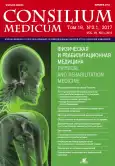The use of the method of robotic kinesitherapy in patients with sequelae of stroke
- Authors: Bronnikov V.A1,2, Smychek V.B3, Mavlikaeva Y.A4, Kravtzov Y.I1, Sklyannaya K.A1,2
-
Affiliations:
- Academician E.A.Wagner Perm State University of the Ministry of Health of the Russian Federation
- Perm Regional Complex Rehabilitation Centre
- Republican Scientific and Practical Centre of Medical Expertise and Rehabilitation
- Main Bureau of Medical and Social Expertise Krai in Perm
- Issue: Vol 19, No 2-1 (2017)
- Pages: 49-52
- Section: Articles
- URL: https://journals.rcsi.science/2075-1753/article/view/94674
- ID: 94674
Cite item
Full Text
Abstract
Keywords
Full Text
##article.viewOnOriginalSite##About the authors
V. A Bronnikov
Academician E.A.Wagner Perm State University of the Ministry of Health of the Russian Federation; Perm Regional Complex Rehabilitation Centre
Email: bronnikov66@mail.ru
д-р мед. наук, проф., зав. каф. физической культуры и здоровья с курсами медико-социальной и физической реабилитации ФПК и ППС ФГБОУ ВО «ПГМУ им. академика Е.А.Вагнера», дир. КГАУ «Центр комплексной реабилитации инвалидов», врач-невролог, гл. внештатный специалист по реабилитации Минздрава Пермского края 614990, Russian Federation, Perm, ul. Petropavlovskaia, d. 26; 614094, Russian Federation, Perm, ul. Sviazistov, d. 11a
V. B Smychek
Republican Scientific and Practical Centre of Medical Expertise and Rehabilitation
Email: priemnaia.meir@mail.ru
д-р мед наук, дир. ГУ «РНПЦ медицинской экспертизы и реабилитации» 223027, Republic of Belarus, Minskaia obl., Minskii r-n, pos. Gorodishche
Yu. A Mavlikaeva
Main Bureau of Medical and Social Expertise Krai in Perm
Email: mavlikaeva@mail.ru
д-р мед. наук, врач по МСЭ, нач. организационно-методического отд. ФКУ ГБ МСЭ по Пермскому краю 614010, Russian Federation, Perm, ul. Komsomol'skii pr-t, d. 77
Yu. I Kravtzov
Academician E.A.Wagner Perm State University of the Ministry of Health of the Russian Federationчл.-кор. РАЕ, д-р мед. наук, проф. ФГБОУ ВО «ПГМУ им. академика Е.А.Вагнера», засл. деят. науки РФ 614990, Russian Federation, Perm, ul. Petropavlovskaia, d. 26
K. A Sklyannaya
Academician E.A.Wagner Perm State University of the Ministry of Health of the Russian Federation; Perm Regional Complex Rehabilitation Centre
Email: skks1008@mail.ru
аспирант каф. физической культуры и здоровья с курсом медико-социальной и физической реабилитации ФПК и ППС ФГБОУ ВО «ПГМУ им. академика Е.А.Вагнера», врач-невролог КГАУ «Центр комплексной реабилитации инвалидов» 614990, Russian Federation, Perm, ul. Petropavlovskaia, d. 26; 614094, Russian Federation, Perm, ul. Sviazistov, d. 11a
References
- Lozano R, Naghavi M, Foreman K et al. Global and regional mortality from 235 causes of death for 20 age groups in 1990 and 2010: a systematic analysis for the Global Burden of Disease Study 2010. Lancet 2012; 380 (9859): 2095-128. doi: 10.1016/s0140-6736(12)61728-0.
- Плотникова О.А., Мавликаева Ю.А. Анализ инвалидности взрослого населения Пермского края вследствие инсульта. Проблемы соц. гигиены, здравоохранения и истории медицины. 2014; 2: 17-9.
- Westlake K, Patten C. Pilot study of Lokomat versus manual - assisted treadmill training for locomotor recovery post - stroke. J Neuro Engineering Rehabilitation 2009; 6 (1): 18. doi: 10.1186/1743-0003-6-18
- Huang V, Krakauer J. Robotic neurorehabilitation: a computational motor learning perspective. J Neuro Engineering Rehabilitation 2009; 6 (1): 5. doi: 10.1186/1743-0003-6-5.
- Кравцов Ю.И., Бронников В.А., Вильдеман А.В. и др. Эффективность комплексной кинезиотерапии у пациентов с тяжелыми двигательными нарушениями. Физиотерапия, бальнеология и реабилитация. 2013; 5: 48-9.
- Husemann B, Muller F, Krewer C et al. Effects of Locomotion Training With Assistance of a Robot-Driven Gait Orthosis in Hemiparetic Patients After Stroke: A Randomized Controlled Pilot Study. Stroke 2007; 38 (2): 349-54. doi: 10.1161/01.str.0000254607.48765.cb
- Langhorne P, Coupar F, Pollock A. Motor recovery after stroke: a systematic review. Lancet Neurology 2009; 8 (8): 741-54. doi: 10.1016/s1474-4422(09)70150-4
- Mehrholz J, Elsner B, Werner C et al. Electromechanical-Assisted Training for Walking After Stroke: Updated Evidence. Stroke 2013; 44 (10): e127-e128. doi: 10.1161/strokeaha.113.003061
- Meiner Z, Fisher I, Katz-Leurer M et al. The Effectiveness of Locomotor Therapy Using Robotic - assisted Gait Training in Subacute Stroke Patients: A Randomized Controlled Trial. PM&R 2009; 1 (9): S99. doi: 10.1016/j.pmrj.2009.08.004
- Geroin C, Mazzoleni S, Smania N et al. Systematic review of outcome measures of walking training using electromechanical and robotic devices in patients with stroke. J Rehabilitation Med 2013; 45 (10): 987-96. doi: 10.2340/16501977-1234
- Van Nunen M, Gerrits K, Konijnenbelt M et al. Recovery of walking ability using a robotic device in subacute stroke patients: a randomized controlled study. Disabil Rehabil: Assistive Technology 2015; 10 (2): 141-8. doi: 10.3109/17483107.2013.873489
- Dundar U, Toktas H, Solak O et al. A Comparative Study of Conventional Physiotherapy Versus Robotic Training Combined with Physiotherapy in Patients with Stroke. Topics in Stroke Rehabilitation 2014; 21 (6): 453-61. doi: 10.1310/tsr2106-453
- Черникова Л.А., Клочков А.С. Влияние тренировок на роботизированной системе Lokomat на мобильность при ходьбе у пациентов с постинсультными гемипарезами. Вопросы курортологии, физиотерапии и лечебной физической культуры. 2014; 3: 13-7.
- Bronnikov V.A, Sklyannaya K.A. Possibilities of Medical and Social Rehabilitation After Stroke; International Neurorehabilitation Symposium 2013; September 11-13, 2013; Zurich, Switzerland. http://www.inrs2013.com/fileadmin/user_upload/posters/12_Bronnikov_et_al_INRS_2013.pdf
- Rosa M, Marques A, Demain S, Metcalf C. Knee posture during gait and global functioning post - stroke: a theoretical ICF framework using current measures in stroke rehabilitation. Disabil Rehabil 2015; 37 (10): 904-13. doi: 10.3109/09638288.2014.948132
- Sivan M, O’Connor R, Makower S et al. Systematic review of outcome measures used in the evaluation of robot - assisted upper limb exercise in stroke. J Rehabilitation Med 2011; 43 (3): 181-9. doi: 10.2340/16501977-0674
Supplementary files






